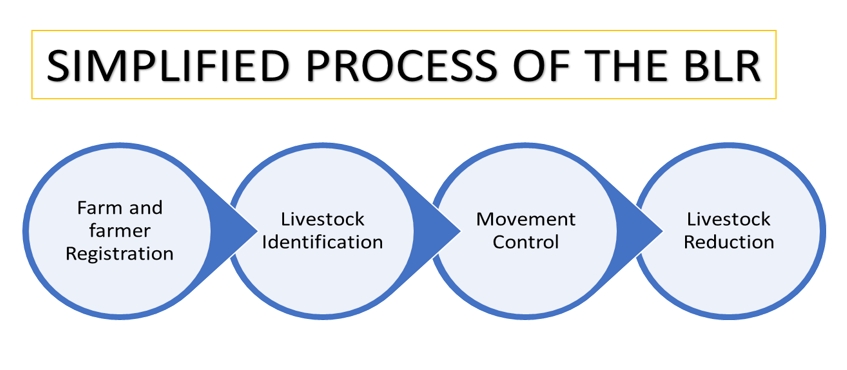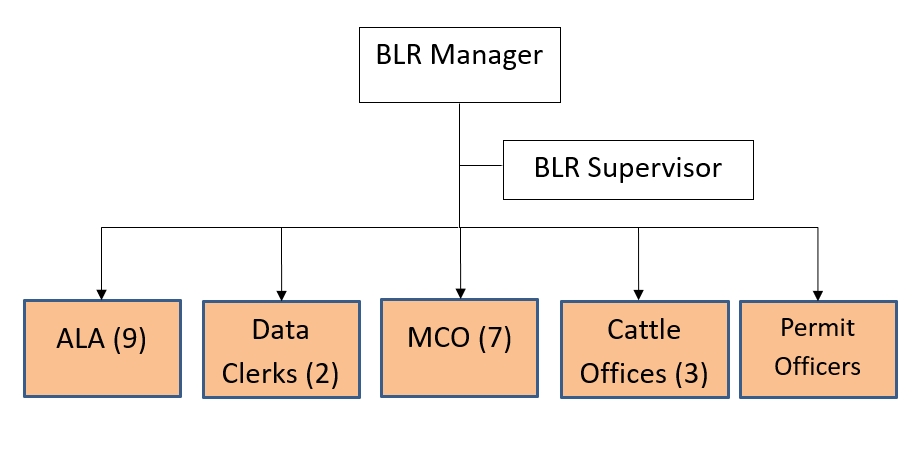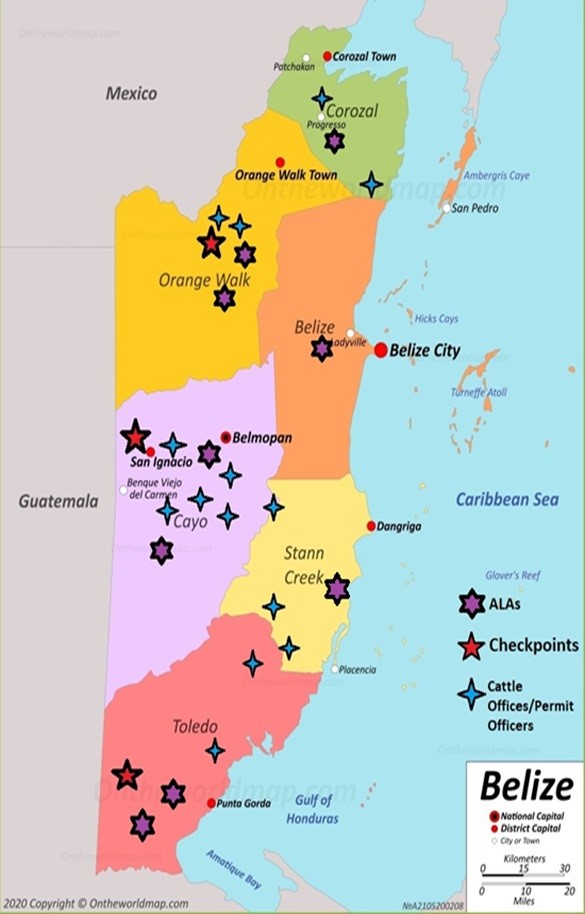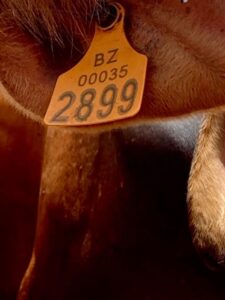The Belize Livestock Registry (BLR)

A Synopsis of BLR
The BLR system is composed of 4 main components:

The traceability process
The traceability process begins with comprehensive registration of farmers and farms, capturing essential information to create a systematic database. This ensures accountability and facilitates communication within the livestock supply chain. Each animal is then assigned a unique identifier using methods like electronic ear tags or RFID technology. This allows for accurate tracking, aiding in record-keeping, disease control, and ensuring the traceability of each animal to its specific farm. Movement control involves monitoring and controlling livestock movement. This is crucial for disease prevention and allows for quick response to outbreaks. A well-established system enables tracking and verification of cattle movement, ensuring the safety of the food supply chain. Lastly, livestock reduction plays a vital role in traceability by tracking the destination and purpose of each animal. This information is valuable for regulatory compliance, quality control, and maintaining transparency throughout the supply chain, addressing issues related to animal welfare and farm management.


Locations
The structure of the BLR consists of the following:
- 20 permit officers distributed in all districts of Belize
- 3 cattle offices located in Spanish lookout, Shipyard and Blue Creek
- 7 Movement Control Officers (3 Checkpoint)
- 2 Data Entry Clerks
- 9 Authorized local agents (ALAs)
The BLR program is being managed by Mr. Elio Pulido assisted by Sarai Pineda
The Map on the left shows the position of the field staff at any given moment.
FARMER REGISTRATION
Rules and Regulations to register as a Livestock Farmer:
- Applicant MUST have cattle.
- Applicant can call or visit the main office in Belmopan to initiate the process; additionally, they can call an authorized local agent (ALA) in their respective district to schedule registration.
- Provide a copy of a valid passport or social security.
- The ALA will visit and register the location where the animal(s) are kept to get data needed.
- Cattle MUST be tagged to register cattle in the BLR.
Once you’ve completed the registration process, you’ll be officially enrolled in the BLR system, enabling you to start having cattle registered under your name in the BLR traceability system.
Tagging
 What is Tagging?
What is Tagging?
Cattle tagging is the process of attaching a permanent identification to a live animal. It is used to track and study animal’s movements, behaviour, demographics, and health. Animal Identification (Cattle) is legislated.
Tagging your cattle serves multiple purposes:
Identification: Tags allow you to identify individual animals within your herd. This is essential for record-keeping, breeding programs, and health monitoring.
Traceability: In the event of disease outbreaks or other emergencies, tagged cattle can be traced back to their origin, helping to contain and manage the situation effectively.
Management: Tags help you keep track of important information such as birth dates, vaccination records, and breeding history, allowing for better management of your herd.
To initiate the process, you first need to be registered as a cattle farmer and register the establishment where the animal(s) are kept.
FAQs:
What are the BLR fees?
| Item | Cost |
|---|---|
| Ear Tags | $10 |
| Livestock Farmer Registration | Free of Cost |
| Local Movement Permit | Free of Cost |
| Export Movement Permit | $10 |
| Export CESS | $10 |
| Export Subsidy | $10 |
| Cattle Traders’ License | $100 |
| Cattle Slaughter | $8 |
| Pig Export/Slaughter | $1 |
| Sheep Export/Slaughter | $2 |
What is the transfer of ownership process?
Transferring ownership of animals involves several steps to ensure legal and proper documentation. To initiate the process:
- Visit the BLPA office or contact the ALA in your area.
- Present a Valid ID (Social Security or Passport) of both parties involved.
- An Authorization Letter provided by BLPA or the current owner, including information such as the number of animals and signatures of both parties involved, is required for official documentation purposes.
- If the new owner is not already registered, they will need to complete the registration process. Furthermore, an agent will visit the farm to conduct an audit to ensure that all ear tags correspond accurately with the information recorded in the BLR system.
Standard Procedure for Change of Ownership Following the Death of a Registered Farmer.
When a family member who owns cattle passes away, claiming ownership involves following legal protocols and procedures. Typically, this requires providing proof of the deceased relative’s ownership, such as a will and testament, along with evidence of your relationship to the deceased. Generally, the farmer’s closest family members, such as a spouse or children, will have the first right to inherit the cattle.
When a farmer passes away without having an agreement (Will and testament) in place to determine who will inherit the cattle on the ranch, to ensure a smooth transition of cattle ownership rights, one must:
- Take an inventory of the animals (Audit)
- Send Death Certificate or Cause of Death
- If family members can come to a mutual agreement, a formal standard document issued by the BLR should be filled out and signed by all parties involved.
If family members refuse to make a mutual agreement and decide to take case to court:
- Once we get a letter from their lawyer, we will file that this person’s farm is in caution and inform all parties involved. No Movement Permit will be issued until a formal agreement has been made by the court.
- When the case closes and there is a final decision, we will issue a letter informing ALAs that they can proceed to issue Movement Permits.
Steps to Become a Registered Livestock Farmer:
To initiate the process of becoming a livestock farmer officially, reach out to your local Authorized Local Agent (ALA). These ALAs are conveniently located in every district across Belize. Alternatively, you can visit the main office of the Belize Livestock Producers Association (BLPA) to complete a registration form.
The registration form will require basic information such as your full name, social security or passport number, address, and contact number.
How to register your farm or establishment:
Arrange a suitable date with your local ALA to visit your farm. The ALA will assist in completing the Establishment section of the registration form. This section entails details like Farm Name, Production Type, Farm GPS coordinates, and the acreage designated for livestock.
If you're renting a farm or sharing it with a family member:
Make sure to inform the ALA or the office staff helping you if you’re renting pasture. This detail will be noted on the registration form.
Once you’ve filled out the registration form, you’ll be officially enrolled in the BLR system, enabling you to start purchasing cattle which will be recorded under your name in the BLR traceability system.
MOVEMENT CONTROL IN CATTLE AND ANIMAL IDENTIFICATION REGULATION SI No.77 of 2011
- Livestock owners or keepers of establishments must apply for a Movement Permit from BLPA before moving animals and record all movements for traceability.
- Newborn animals must be tagged within six months of birth or before leaving the farm. The cost of an ear tag is $10 and provided only by BLPA’s Authorized Local Agents and Permit Officers.
- If an animal dies, the owner must remove the ear tag and report the death to the ALA or BLR staff for record traceability.
- Unauthorized removal, application, or alteration of ear tags is prohibited.
Note:
- Violations of these regulations can result in fines up to Five Thousand dollars or imprisonment for up to Three years.
- Fees imposed by the Belize Agricultural Health Authority are the responsibility of the owner, keeper, or producer unless otherwise specified.
BLR Office Staff

Elio Pulido
BLR Manager

Sarai Pineda
BLR Supervisor

Andrew Balan
Data Entry Clerk

Noe Oliva
Data Entry Clerk
